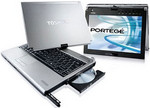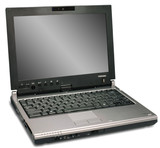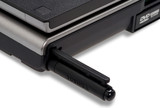Toshiba Portégé M700
Especificaciones de Portátil(es)

Price comparison
Promedio de 11 puntuaciones (de 11 análisis)
Análisis para el Toshiba Portégé M700
Origen: Tech Advisor
 EN→ES Archive.org version
EN→ES Archive.org versionThis earnest laptop is a jack of many trades, with a good selection of features and relatively impressive battery life for untethered productivity. The price premium over a comparably specified regular laptop will be a good investment if you need a versatile laptop-cum-tablet that works well in either guise.
(von 5): 3.5, Verarbeitung 3.5, Ausstattung 4, Preis 3.5, Mobilität gut
Único Análisis, disponible online, corto, Fecha: 05/23/2008
Puntuación: Puntuación total: 70% precio: 70% características: 80% movilidad: 80% procesamiento: 70%
Origen: PC Mag
 EN→ES Archive.org version
EN→ES Archive.org versionAlthough its tablet PC lineup may not be as impressive as Fujitsu 's, Toshiba has put together a solid and diverse array of convertible tablets over the past several years. The Toshiba Portégé M700-S7002 ($1,799 direct) is a convertible tablet that competes with the Fujitsu LifeBook T4000 Series and the ASUS R1, offering a wide selection of bred-for-performance, standard-voltage processors. This convertible tablet has the processing capability and an optical drive to maintain productivity at a high level.
4 von 5, Leistung exzellent
Único Análisis, disponible online, Mediano, Fecha: 04/11/2008
Puntuación: Puntuación total: 80% rendimiento: 95%
Origen: Laptop Mag
 EN→ES Archive.org version
EN→ES Archive.org versionPriced at $1,799, the Toshiba Portégé M700-S7002 is a very good choice for road warriors who demand power, portability, and the flexibility of having both touch and pen input. Although it’s a bit on the thick side, the M700-S7002 is a top-notch performer that can stand up to business travelers.
4 von 5, Leistung gut, Mobilität gut
Único Análisis, disponible online, corto, Fecha: 03/17/2008
Puntuación: Puntuación total: 80% rendimiento: 80% movilidad: 80%
Origen: Trusted Reviews
 EN→ES Archive.org version
EN→ES Archive.org versionThere's no denying that the Portégé M700 is well specified and that Toshiba has priced it competitively for a fully featured Tablet device. However, it's bigger and heavier then most 12.1in notebooks, and it lacks the solid build quality of the business behemoth that is the Lenovo ThinkPad. The keyboard is particularly disappointing, but if you're planning to use it mostly in Tablet mode, that probably won't bother you. There's not much that's intrinsically wrong with the M700, but there's nothing that stands out as particularly good either. This latest Portégé definitely hasn't convinced me of the merits of Tablet computing, but to be fair to Toshiba, I doubt that anything could.
(von 10): 7, Ausstattung 8, Leistung 7, Verarbeitung schlecht
Único Análisis, disponible online, Mediano, Fecha: 03/17/2008
Puntuación: Puntuación total: 70% rendimiento: 70% características: 80% procesamiento: 40%
Origen: vnunet.com
 EN→ES Archive.org version
EN→ES Archive.org versionAlthough 2kg isn’t heavy for a laptop when carried in a shoulder bag, actually holding it in your hands is a different matter and, after 15 minutes or so, you’ll most likely be struggling. Combine this with the premium you’re paying for the tablet design and alternatives such as ultraportable laptops or UMPCs start to look more attractive.
(von 5): 3, Ausstattung 4, Leistung 3
Único Análisis, disponible online, corto, Fecha: 02/29/2008
Puntuación: Puntuación total: 60% rendimiento: 60% características: 80%
Origen: PC Pro
 EN→ES Archive.org version
EN→ES Archive.org versionNot only does this fail to compete with the best tablets in its price range, but it is also too expensive for those who would only occasionally spin the screen and hide the keyboard. Attractive to look at, but too expensive for occasional tablet use and not good enough to compete with the best dedicated devices.
3 von 6, Preis/Leistung schlecht
Único Análisis, disponible online, corto, Fecha: 01/31/2008
Puntuación: Puntuación total: 50% precio: 40%
Origen: Notebook / Organizer / Handy - 3-4/09

Comparación, , Longitud Desconocida, Fecha: 02/01/2009
Puntuación: Puntuación total: 90% pantalla: 80%
Origen: SFT - 1/09

Comparación, , Longitud Desconocida, Fecha: 01/01/2009
Puntuación: Puntuación total: 96% rendimiento: 80% características: 80% emisiones: 80%
Origen: SFT - 1/09

Comparación, , Longitud Desconocida, Fecha: 01/01/2009
Puntuación: Puntuación total: 92% rendimiento: 40% movilidad: 80% emisiones: 80%
Origen: Notebook / Organizer / Handy - 11-12/08

Único Análisis, , Longitud Desconocida, Fecha: 12/01/2008
Puntuación: Puntuación total: 90% precio: 80% rendimiento: 80%
Origen: PCM
 NL→ES Archive.org version
NL→ES Archive.org versionÚnico Análisis, disponible online, corto, Fecha: 04/21/2008
Puntuación: Puntuación total: 78% rendimiento: 72% movilidad: 80% ergonomía: 90%
Comentario
Intel Graphics Media Accelerator (GMA) X3100: Intel Graphics Media Accelerator (GMA) X3100 es un chip de video integrado (incorporado) en un chipset de Mobile Intel 965GM (para Merom =Core 2 arquitectura). Es el sucesor del Intel GMA 950. Lo más interesante es la integración de un pipeline completamente programable. Debido a la integración de características Direct X9, HDR y Hardware Transform & Lighning (T&L) – su predecesor solo tenía Software T&L – debería estar listo para Windows Vista Premium (soporte Aero Glass completamente). Con respecto a los datos, el rendimiento debe ser claramente mejor al de GMA 950.
Muchos juegos son difícilmente ejecutables con estos adaptadores gráficos o se ejecutan de manera muy lenta.
>> Más información puede ser encontrada en nuestra comparación de tarjetas gráficas moviles y la lista de benchmarks.
Intel Core 2 Duo: Este es el sucesor Core Duo y el Core Solo con un pipeline más largo y con una velocidad entre 5-20% sin mayor consumo de energía. Adicional al diseño de Core Duo existe un cuarto decodificador, una unidad SSE ampliada y una unidad lógica aritmética (ALU) adicional.
Sus características son: 2 núcleos (cores), una amplificación de comando de 64-bit EM64T y 2 o 4 MB L2 Cache y 291 millones de transistores, que son acabados en 65nm. Mas allá de esto, todos los tipos soportan técnicas "Execute Disable Bit", SSSE3 (SSE4), Enhanced Speedstep, LaGrande y la mayoría de técnicas de virtualizacion (VT) Vanderpool.
El Core 2 Duo para laptops es idéntico a los procesadores Core 2 Duo para desktops, pero los procesadores para notebooks trabajan con tensiones más bajas (0.95 a 1188 Volt) y un Frontside bus clock (1066 contra 667 MHz). El rendimiento de laptops cuena con una frecuencia de 20-25% más baja que PCs Desktop debido a una frecuencia más baja de Frontside bus y los discos duros más lentos.
T7500: El Core 2 Duo T7500 es un Core 2 Duo basado en arquitectura Merom con 4 MB de Cache de nivel 2. Se situa en la gama media (en 2009) y rinde a la par que los modernos P7550 o Turion II Ultra M640/M660.
>> Más información puede ser encontrada en nuestra comparación de procesadores móviles.









